Numerical Study of Flow and Heat Transfer Characteristics for Al2O3 Nanofluid in a Double-Pipe Helical Coil Heat Exchanger
Abstract
:1. Introduction
2. Numerical Methods
2.1. Two-Phase Model
2.2. Simulation Geometry and Boundary Conditions
2.3. Validation of Simulation
2.3.1. Mesh Independence Test
2.3.2. Model Validation
3. Results and Discussion
3.1. Flow and Temperature Distributions in Double-Pipe Helical Coil Heat Exchanger
3.2. Heat Transfer Characteristics of Nanofluids
3.3. Pressure Drop
3.4. Performance Evaluation of Nanofluids
4. Conclusions
- (1)
- A comparison of the velocity profiles with different coil lengths (i.e., degrees) revealed that the flow in the double-pipe helical coil heat exchanger was fully developed after two rotations (i.e., 720 degrees). The flow and heat transfer characteristics (i.e., heat transfer coefficient, Nusselt number, and pressure drop) were accordingly evaluated after two rotations to reflect the fully developed flows.
- (2)
- Convective heat transfer was enhanced as the flow rate of nanofluids increased, as indicated by the large heat transfer coefficient and Nusselt number. The heat transfer was also enhanced as the nanofluid concentration (i.e., volume fraction) rose. The 1.0 vol.% nanofluid (i.e., the highest concentration) showed a heat transfer coefficient 1.43 times and a Nusselt number 1.38 times greater than water due to the improved thermal properties (i.e., thermal conductivity).
- (3)
- The pressure drop was significantly affected by the flow rate conditions. As the flow rate increased, the pressure drop increased due to the high dynamic pressure loss and enhanced turbulence in the curved pipe. Additionally, the pressure drop of the nanofluids that flowed through the heat exchanger was greater than that of water, with an increase rate of up to 3%. This was because of the enhanced flow resistance caused by the increased viscosity with an increased nanofluid concentration.
- (4)
- The energy efficiency of the nanofluids was evaluated by calculating the performance factor based on the Nusselt number and pressure drop. The 1.0 vol.% nanofluid had a performance factor of 1.4 relative to water, which means that the Al2O3 nanofluids showed a much larger enhanced heat transfer performance compared to the increased pressure drop, so that the Al2O3 nanofluids can be used as an improved heat transfer fluid.
Author Contributions
Funding
Data Availability Statement
Conflicts of Interest
Nomenclature
| D | Diameter (m) |
| F | Force (N) |
| f | Friction factor |
| g | Gravitational acceleration (m/s2) |
| h | Heat transfer coefficient (W/m2K) |
| K | Interface momentum transfer coefficient |
| k | Thermal conductivity (W/mK) |
| Nu | Nusselt number |
| P | Pressure (N/m2) |
| PF | Performance factor |
| Pr | Prandtl number |
| Q | Heat transfer rate (W) |
| R | Radius (m) |
| r | r-axis distance (m) |
| Re | Reynold number (-) |
| T | Temperature (°C) |
| u | Flow velocity (m/s) |
| v | Velocity (m/s) |
| Greek letters | |
| μ | Dynamic viscosity (kg/m∙s) |
| ρ | Density (kg/m3) |
| φ | Volume fraction |
| Subscripts | |
| h | Hydraulic diameter |
| l | Liquid phase |
| lift | Lift force |
| NF | Nanofluid |
| s | Solid phase |
| vm | Virtual mass force |
| w | Water |
References
- Wen, R.; Li, Q.; Wang, W.; Latour, B.; Li, C.H.; Li, C.; Lee, Y.-C.; Yang, R. Enhanced bubble nucleation and liquid rewetting for highly efficient boiling heat transfer on two-level hierarchical surfaces with patterned copper nanowire arrays. Nano Energy 2017, 38, 59–65. [Google Scholar] [CrossRef]
- Song, Y.; Gong, S.; Vaartstra, G.; Wang, E.N. Microtube Surfaces for the Simultaneous Enhancement of Efficiency and Critical Heat Flux during Pool Boiling. ACS Appl. Mater. Interfaces 2021, 13, 12629–12635. [Google Scholar] [CrossRef]
- Li, W.; Luo, K.; Li, C.; Joshi, Y. A remarkable CHF of 345W/cm2 is achieved in a wicked-microchannel using HFE-7100. Int. J. Heat Mass Transf. 2022, 187, 122527. [Google Scholar] [CrossRef]
- Schell, F.; Chukwudi Okafor, R.; Steege, T.; Alamri, S.; Ghevariya, S.; Zwahr, C.; Lasagni, A.F. Increasing Heat Transfer from Metal Surfaces through Laser-Interference-Induced Microscopic Heat Sinks. Micromachines 2023, 14, 1730. [Google Scholar] [CrossRef]
- Nam, H.T.; Cho, H.H.; Lee, S.; Lee, D. Temperature-dependent wicking dynamics and its effects on critical heat flux on micropillar structures in pool boiling heat transfer. Int. Commun. Heat Mass Transf. 2023, 146, 106887. [Google Scholar] [CrossRef]
- Mahmoudi, M.; Tavakoli, M.R.; Mirsoleimani, M.A.; Gholami, A.; Salimpour, M.R. Experimental and numerical investigation on forced convection heat transfer and pressure drop in helically coiled pipes using TiO2/water nanofluid. Int. J. Refrig. 2017, 74, 627–643. [Google Scholar] [CrossRef]
- Sahin, B.; Gültekin, G.G.; Manay, E.; Karagoz, S. Experimental investigation of heat transfer and pressure drop characteristics of Al2O3–water nanofluid. Exp. Therm. Fluid Sci. 2013, 50, 21–28. [Google Scholar] [CrossRef]
- Heyhat, M.M.; Kowsary, F.; Rashidi, A.M.; Alem Varzane Esfehani, S.; Amrollahi, A. Experimental investigation of turbulent flow and convective heat transfer characteristics of alumina water nanofluids in fully developed flow regime. Int. Commun. Heat Mass Transf. 2012, 39, 1272–1278. [Google Scholar] [CrossRef]
- Nasiri, M.; Etemad, S.G.; Bagheri, R. Experimental heat transfer of nanofluid through an annular duct. Int. Commun. Heat Mass Transf. 2011, 38, 958–963. [Google Scholar] [CrossRef]
- Vajjha, R.S.; Das, D.K.; Kulkarni, D.P. Development of new correlations for convective heat transfer and friction factor in turbulent regime for nanofluids. Int. J. Heat Mass Transf. 2010, 53, 4607–4618. [Google Scholar] [CrossRef]
- Wai, O.J.; Gunnasegaran, P.; Hasini, H. A Review on Experimental and Numerical Investigations of Jet Impingement Cooling Performance with Nanofluids. Micromachines 2022, 13, 2059. [Google Scholar] [CrossRef] [PubMed]
- Bouselsal, M.; Mebarek-Oudina, F.; Biswas, N.; Ismail, A.A.I. Heat Transfer Enhancement Using Al2O3-MWCNT Hybrid-Nanofluid inside a Tube/Shell Heat Exchanger with Different Tube Shapes. Micromachines 2023, 14, 1072. [Google Scholar] [CrossRef]
- Bergles, A.E. ExHFT for fourth generation heat transfer technology. Exp. Therm. Fluid Sci. 2002, 26, 335–344. [Google Scholar] [CrossRef]
- Rennie, T.J.; Raghavan, V.G.S. Numerical studies of a double-pipe helical heat exchanger. Appl. Therm. Eng. 2006, 26, 1266–1273. [Google Scholar] [CrossRef]
- Jayakumar, J.S.; Mahajani, S.M.; Mandal, J.C.; Iyer, K.N.; Vijayan, P.K. CFD analysis of single-phase flows inside helically coiled tubes. Comput. Chem. Eng. 2010, 34, 430–446. [Google Scholar] [CrossRef]
- Cioncolini, A.; Santini, L. On the laminar to turbulent flow transition in diabatic helically coiled pipe flow. Exp. Therm. Fluid Sci. 2006, 30, 653–661. [Google Scholar] [CrossRef]
- Choi, S.U.; Eastman, J.A. Enhancing Thermal Conductivity of Fluids with Nanoparticles; Argonne National Lab.(ANL): Argonne, IL, USA, 1995. [Google Scholar]
- Pak, B.C.; Cho, Y.I. Hydrodynamic and heat transfer study of dispersed fluids with submicron metallic oxide particles. Exp. Heat Transf. 1998, 11, 151–170. [Google Scholar] [CrossRef]
- Akbari, M.; Galanis, N.; Behzadmehr, A. Comparative assessment of single and two-phase models for numerical studies of nanofluid turbulent forced convection. Int. J. Heat Fluid Flow 2012, 37, 136–146. [Google Scholar] [CrossRef]
- Sheikholeslami, M.; Ebrahimpour, Z. Nanofluid performance in a solar LFR system involving turbulator applying numerical simulation. Adv. Powder Technol. 2022, 33, 103669. [Google Scholar] [CrossRef]
- Kalteh, M.; Abbassi, A.; Saffar-Avval, M.; Harting, J. Eulerian–Eulerian two-phase numerical simulation of nanofluid laminar forced convection in a microchannel. Int. J. Heat Fluid Flow 2011, 32, 107–116. [Google Scholar] [CrossRef]
- Khosravi-Bizhaem, H.; Abbassi, A. Effects of curvature ratio on forced convection and entropy generation of nanofluid in helical coil using two-phase approach. Adv. Powder Technol. 2018, 29, 890–903. [Google Scholar] [CrossRef]
- Bahremand, H.; Abbassi, A.; Saffar-Avval, M. Experimental and numerical investigation of turbulent nanofluid flow in helically coiled tubes under constant wall heat flux using Eulerian–Lagrangian approach. Powder Technol. 2015, 269, 93–100. [Google Scholar] [CrossRef]
- Rezaei Gorjaei, A.; Soltani, M.; Bahiraei, M.; Kashkooli, F.M. CFD simulation of nanofluid forced convection inside a three-dimensional annulus by two-phase mixture approach: Heat transfer and entropy generation analyses. Int. J. Mech. Sci. 2018, 146–147, 396–404. [Google Scholar] [CrossRef]
- Behroyan, I.; Ganesan, P.; He, S.; Sivasankaran, S. Turbulent forced convection of Cu–water nanofluid: CFD model comparison. Int. Commun. Heat Mass Transf. 2015, 67, 163–172. [Google Scholar] [CrossRef]
- Bianco, V.; Manca, O.; Nardini, S. Numerical investigation on nanofluids turbulent convection heat transfer inside a circular tube. Int. J. Therm. Sci. 2011, 50, 341–349. [Google Scholar] [CrossRef]
- Kumar, N.; Puranik, B.P. Numerical study of convective heat transfer with nanofluids in turbulent flow using a Lagrangian-Eulerian approach. Appl. Therm. Eng. 2017, 111, 1674–1681. [Google Scholar] [CrossRef]
- Göktepe, S.; Atalık, K.; Ertürk, H. Comparison of single and two-phase models for nanofluid convection at the entrance of a uniformly heated tube. Int. J. Therm. Sci. 2014, 80, 83–92. [Google Scholar] [CrossRef]
- Behzadmehr, A.; Saffar-Avval, M.; Galanis, N. Prediction of turbulent forced convection of a nanofluid in a tube with uniform heat flux using a two phase approach. Int. J. Heat Fluid Flow 2007, 28, 211–219. [Google Scholar] [CrossRef]
- Aly, W.I.A. Numerical study on turbulent heat transfer and pressure drop of nanofluid in coiled tube-in-tube heat exchangers. Energy Convers. Manag. 2014, 79, 304–316. [Google Scholar] [CrossRef]
- Huminic, G.; Huminic, A. Heat transfer characteristics in double tube helical heat exchangers using nanofluids. Int. J. Heat Mass Transf. 2011, 54, 4280–4287. [Google Scholar] [CrossRef]
- Kong, M.; Lee, S. Performance evaluation of Al2O3 nanofluid as an enhanced heat transfer fluid. Adv. Mech. Eng. 2020, 12, 1687814020952277. [Google Scholar] [CrossRef]
- ANSYS. ANSYS 18.1 Fluent User’s Guide; ANSYS: Canonsburg, PA, USA, 2017. [Google Scholar]
- Bae, S.W.; Jeong, J.J.; Chang, S.K.; Cho, H.K. Two Phase Flow Models and Numerical Methods of the Commercial CFD Codes; Korea Atomic Energy Research Institute: Daejeon, Republic of Korea, 2007. [Google Scholar]
- Wen, C.Y. Mechanics of fluidization. Chem. Eng. Progress Symp. Ser. 1966, 162, 100–111. [Google Scholar]
- Ranz, W.; Marshall, W. Analysis evaporation from drops. Chem. Eng. Prog. 1952, 48, 141–146. [Google Scholar]
- Popiel, C.; Wojtkowiak, J. Simple formulas for thermophysical properties of liquid water for heat transfer calculations (from 0 °C to 150 °C). Heat Transf. Eng. 1998, 19, 87–101. [Google Scholar] [CrossRef]
- Petukhov, B.S. Heat transfer and friction in turbulent pipe flow with variable physical properties. In Advances in Heat Transfer; Elsevier: Amsterdam, The Netherlands, 1970; Volume 6, pp. 503–564. [Google Scholar]
- El Bécaye Maïga, S.; Tam Nguyen, C.; Galanis, N.; Roy, G.; Maré, T.; Coqueux, M. Heat transfer enhancement in turbulent tube flow using Al2O3 nanoparticle suspension. Int. J. Numer. Methods Heat Fluid Flow 2006, 16, 275–292. [Google Scholar] [CrossRef]
- Khanafer, K.; Vafai, K.; Lightstone, M. Buoyancy-driven heat transfer enhancement in a two-dimensional enclosure utilizing nanofluids. Int. J. Heat Mass Transf. 2003, 46, 3639–3653. [Google Scholar] [CrossRef]
- Zarringhalam, M.; Karimipour, A.; Toghraie, D. Experimental study of the effect of solid volume fraction and Reynolds number on heat transfer coefficient and pressure drop of CuO–Water nanofluid. Exp. Therm. Fluid Sci. 2016, 76, 342–351. [Google Scholar] [CrossRef]
- Wongcharee, K.; Eiamsa-ard, S. Heat transfer enhancement by using CuO/water nanofluid in corrugated tube equipped with twisted tape. Int. Commun. Heat Mass Transf. 2012, 39, 251–257. [Google Scholar] [CrossRef]
- Maradiya, C.; Vadher, J.; Agarwal, R. The heat transfer enhancement techniques and their Thermal Performance Factor. Beni-Suef Univ. J. Basic Appl. Sci. 2018, 7, 1–21. [Google Scholar] [CrossRef]
- Ji, Y.; Xing, K.; Cen, K.; Ni, M.; Xu, H.; Xiao, G. Numerical Study on Flow and Heat Transfer Characteristics of Trapezoidal Printed Circuit Heat Exchanger. Micromachines 2021, 12, 1589. [Google Scholar] [CrossRef]
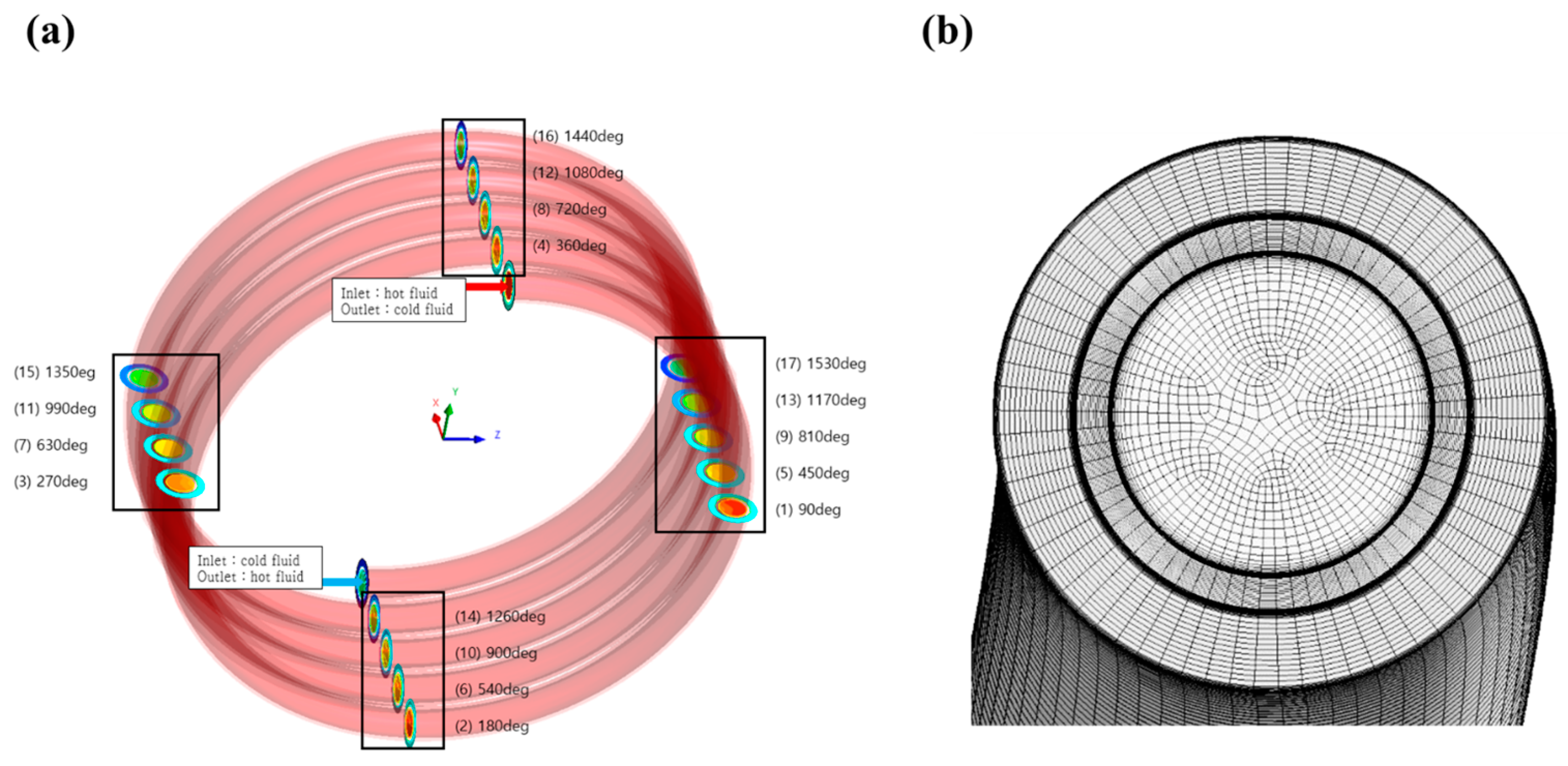
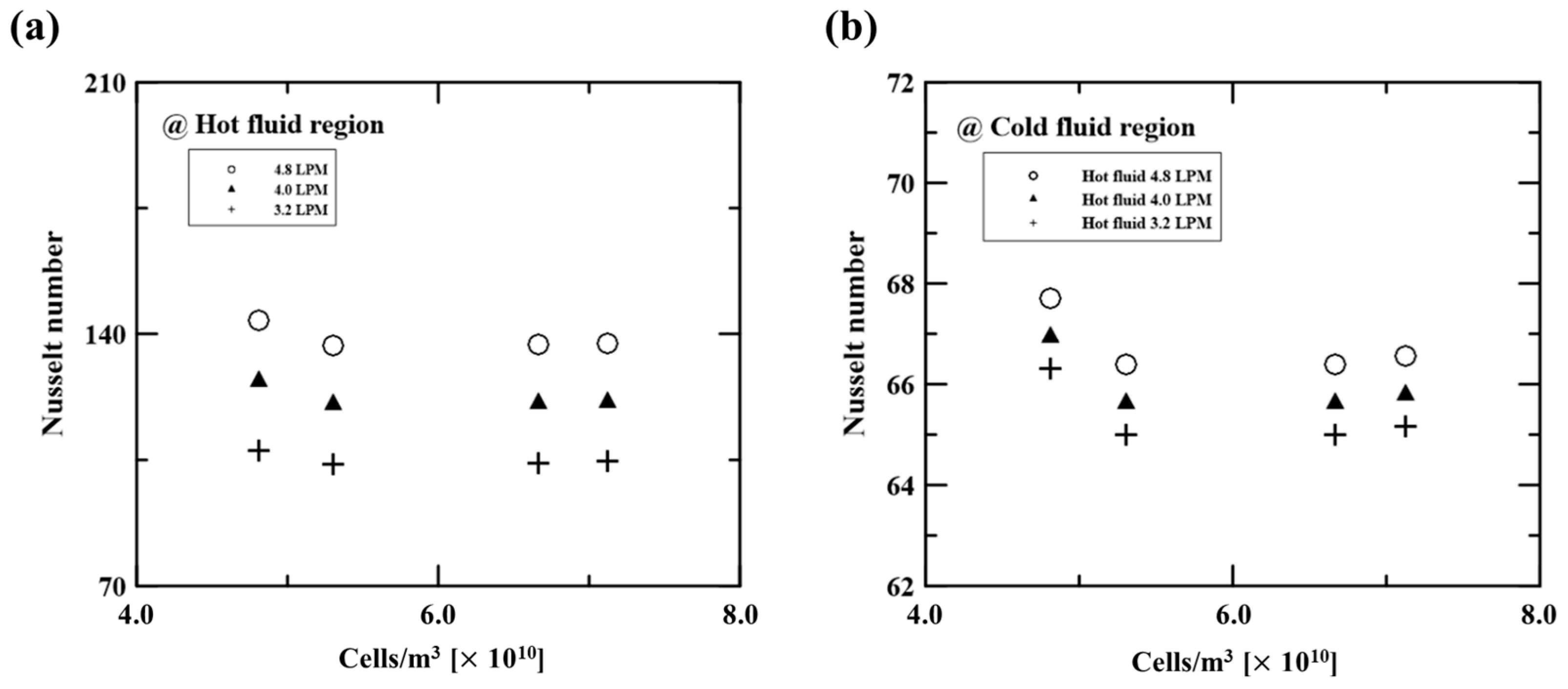

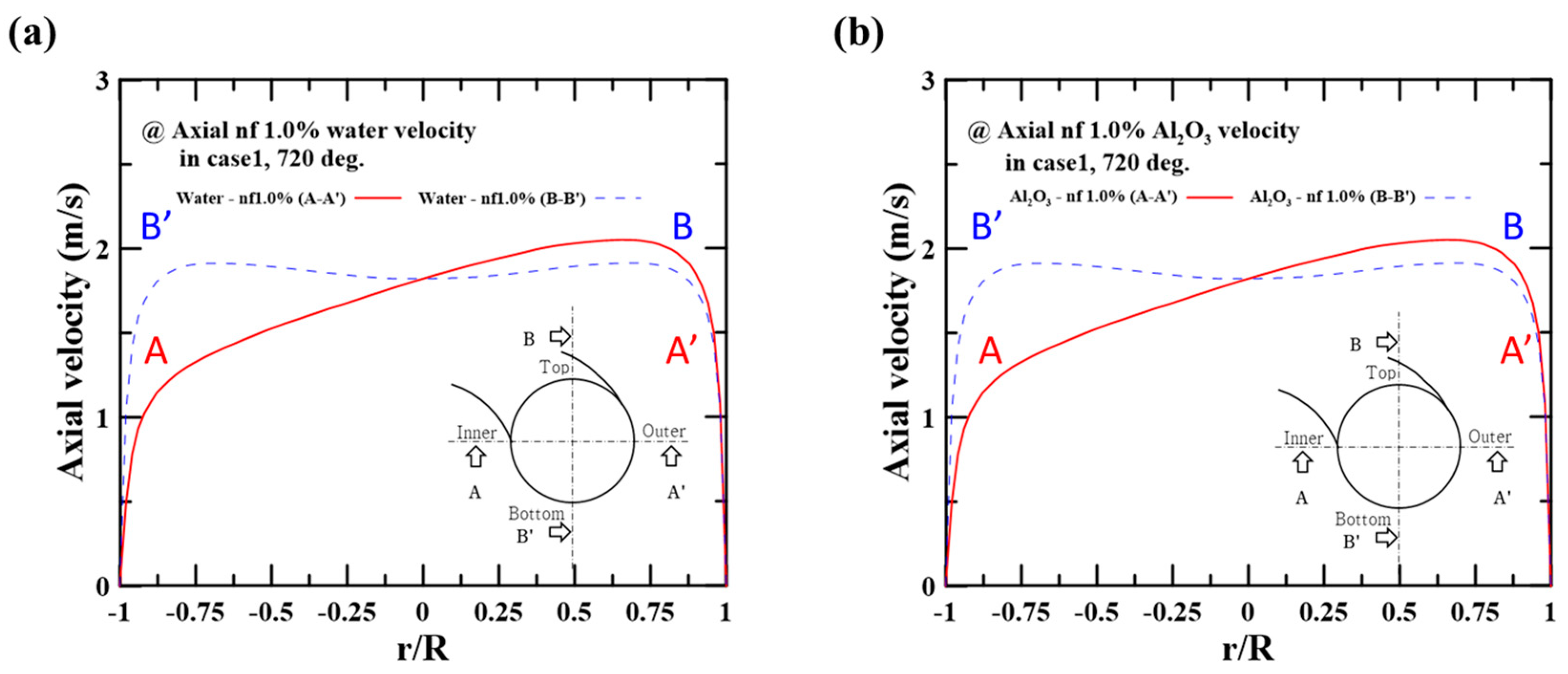
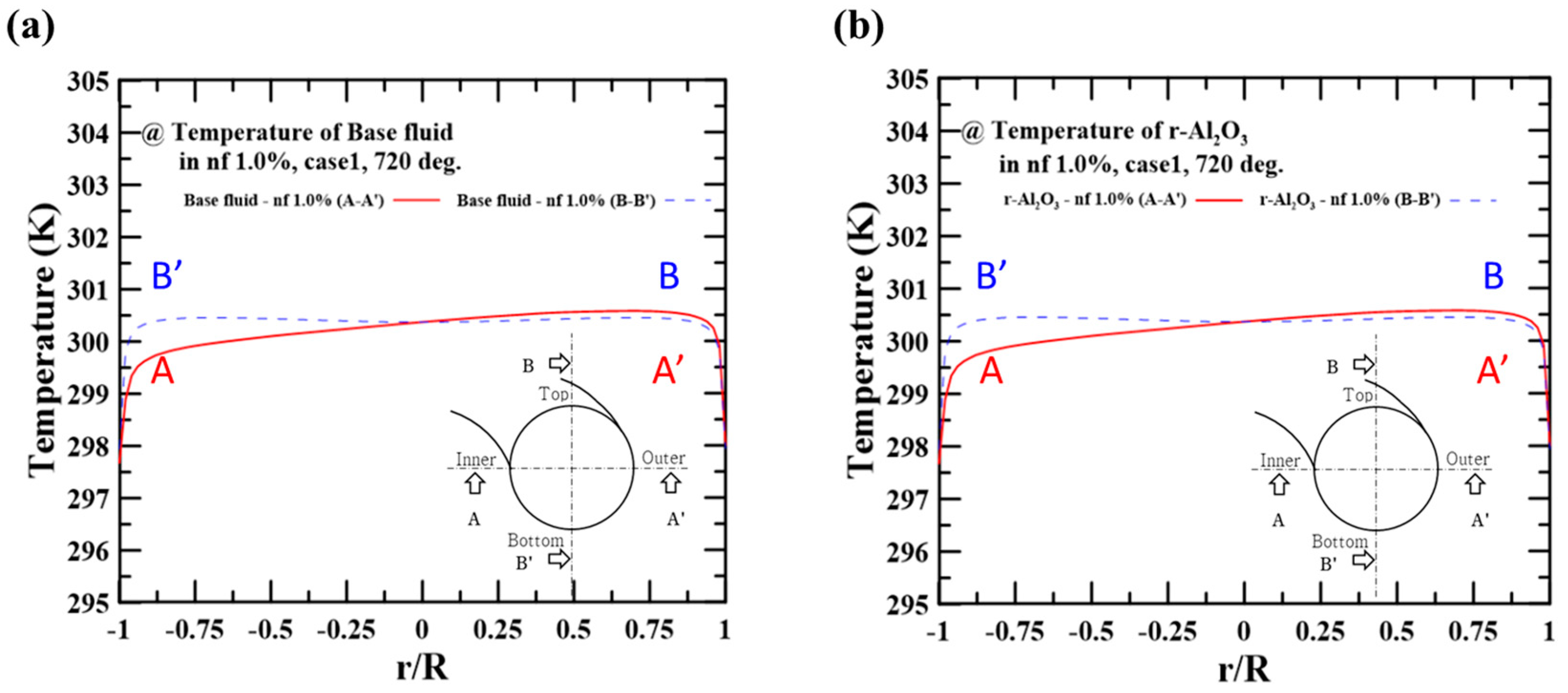

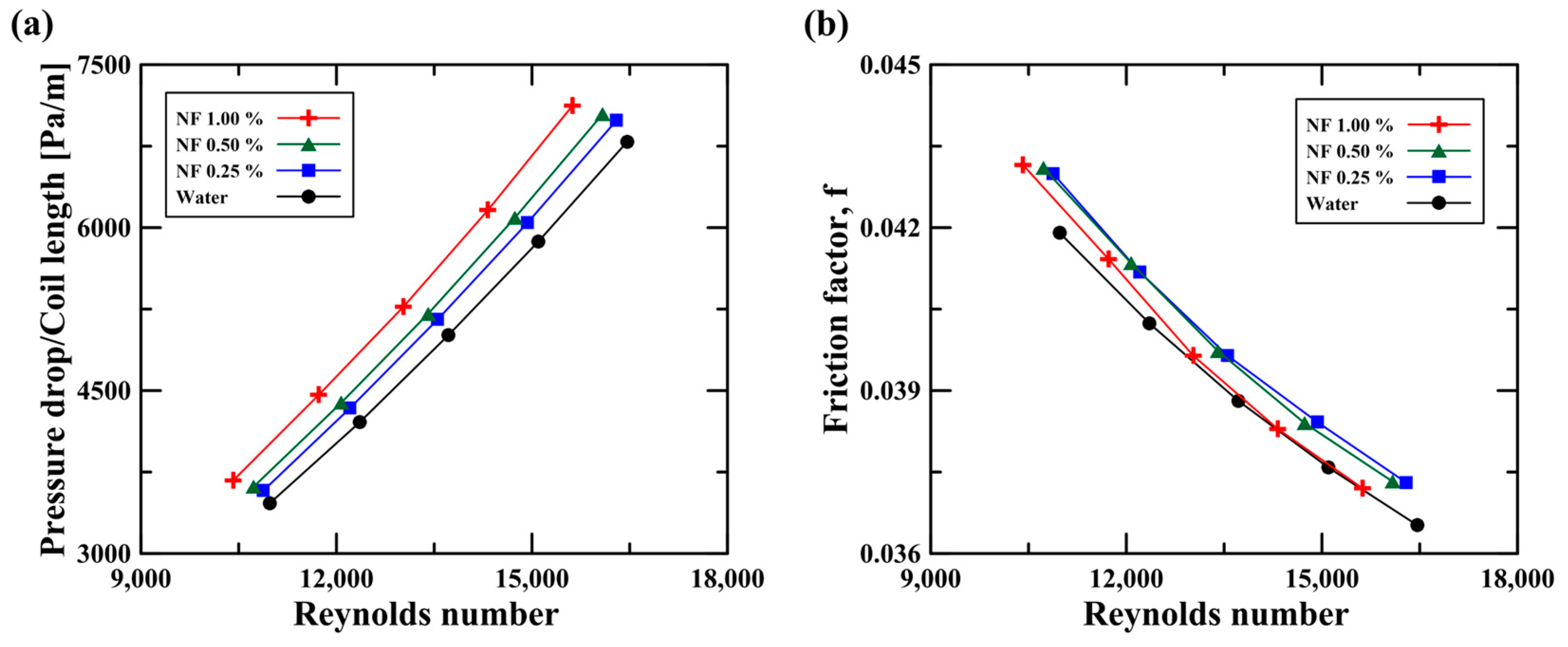
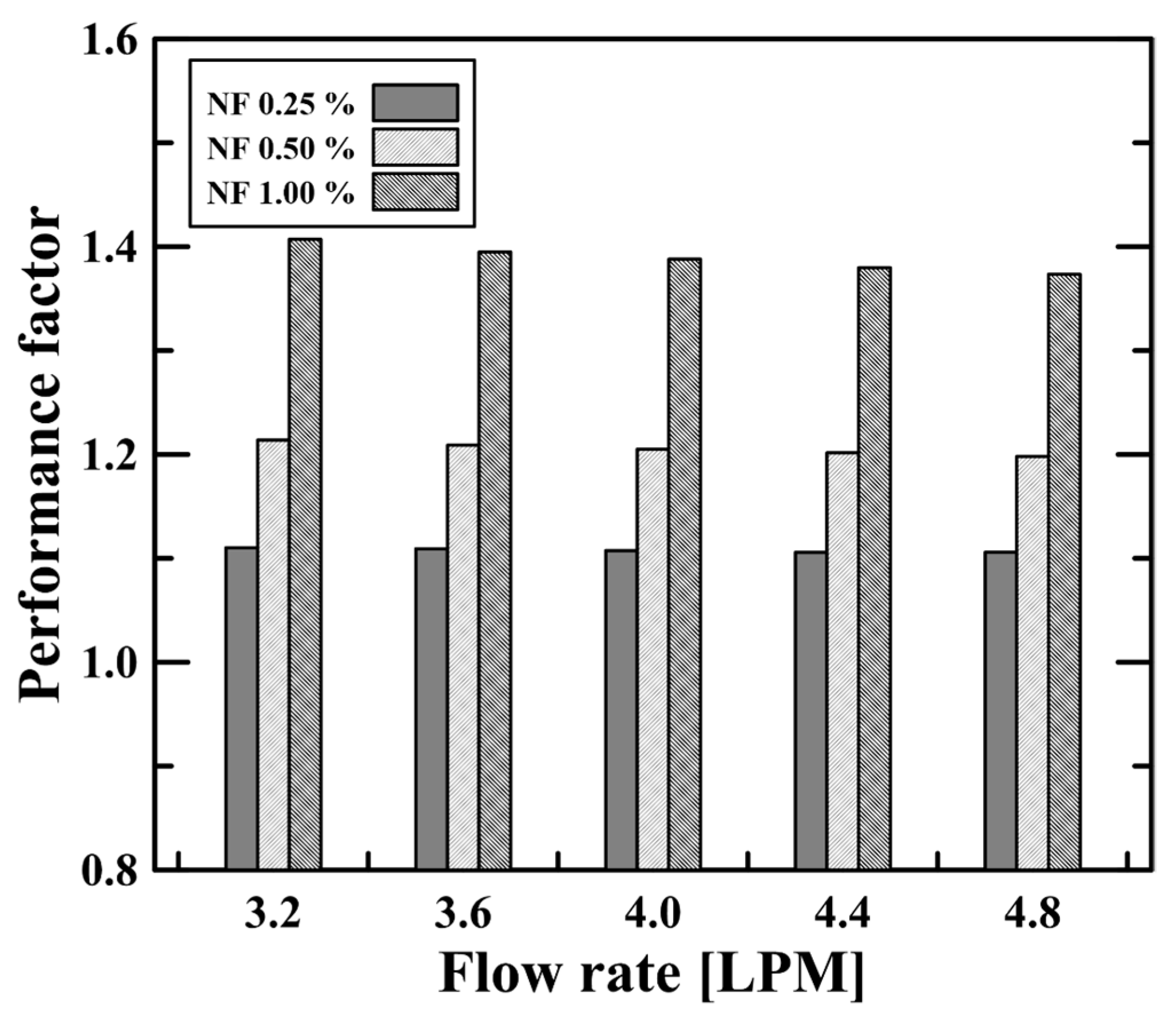
| Inner Tube (Hot Side) | Annulus Tube (Cold Side) | |
|---|---|---|
| Inner diameter | 0.00774 m | 0.01340 m |
| Outer diameter | 0.00952 m | 0.01588 m |
| Coil diameter | 0.1524 m | |
| Coil pitch | 0.0159 m | |
| Turns | 4.5 | |
| Component | Size [nm] | Density [kg/m3] | Specific Heat [J/kg·K] | Thermal Conductivity [W/m·K] |
|---|---|---|---|---|
| Al2O3 | 25 | 3970 | 750 | 46 |
| Water | (see Table 3) | |||
| Water | a | b | c | d |
|---|---|---|---|---|
| Density | −9.10863 × 101 | 1.00043 × 101 | −2.95327 × 10−2 | 2.75649 × 10−5 |
| Viscosity | 2.07186 × 10−1 | −1.91026 × 10−3 | 5.92043 × 10−6 | −6.15166 × 10−9 |
| Thermal conductivity | −1.85073 × 100 | 1.86749 × 10−2 | −4.73644 × 10−5 | 4.16113 × 10−8 |
| Specific heat | Constant value of 4180 J/kg·K | |||
| Solution Method | Model or Scheme |
|---|---|
| Turbulence model | Realizable k-epsilon |
| Near wall treatment | Enhanced wall treatment |
| Pressure-velocity coupling | PC-SIMPLE |
| Gradient | Least-Squares Cell-Based |
| Momentum | QUICK |
| Volume fraction | QUICK |
| Turbulent kinetic energy | Power law |
| Turbulent dissipation rate | Power law |
| Energy | Second order upwind |
| Case No. | Flow Rate at Hot Side | Flow Rate on Cold Side |
|---|---|---|
| Case 1 | 4.8 LPM (Re 15,600~16,500) | 7.2 LPM (Re 6600) |
| Case 2 | 4.4 LPM (Re 14,300~15,100) | |
| Case 3 | 4.0 LPM (Re 13,000~13,700) | |
| Case 4 | 3.6 LPM (Re 11,700~12,400) | |
| Case 5 | 3.2 LPM (Re 10,400~11,000) |
| Case No. | Y+ | Cell/m3 |
|---|---|---|
| Mesh case 1 | 6.50 | 4.8 × 1010 |
| Mesh case 2 | 3.20 | 5.3× 1010 |
| Mesh case 3 | 1.35 | 6.7× 1010 |
| Mesh case 4 | 1.27 | 7.1× 1010 |
Disclaimer/Publisher’s Note: The statements, opinions and data contained in all publications are solely those of the individual author(s) and contributor(s) and not of MDPI and/or the editor(s). MDPI and/or the editor(s) disclaim responsibility for any injury to people or property resulting from any ideas, methods, instructions or products referred to in the content. |
© 2023 by the authors. Licensee MDPI, Basel, Switzerland. This article is an open access article distributed under the terms and conditions of the Creative Commons Attribution (CC BY) license (https://creativecommons.org/licenses/by/4.0/).
Share and Cite
Nam, H.T.; Lee, S.; Kong, M.; Lee, S. Numerical Study of Flow and Heat Transfer Characteristics for Al2O3 Nanofluid in a Double-Pipe Helical Coil Heat Exchanger. Micromachines 2023, 14, 2219. https://doi.org/10.3390/mi14122219
Nam HT, Lee S, Kong M, Lee S. Numerical Study of Flow and Heat Transfer Characteristics for Al2O3 Nanofluid in a Double-Pipe Helical Coil Heat Exchanger. Micromachines. 2023; 14(12):2219. https://doi.org/10.3390/mi14122219
Chicago/Turabian StyleNam, Hyeon Taek, Sumin Lee, Minsuk Kong, and Seungro Lee. 2023. "Numerical Study of Flow and Heat Transfer Characteristics for Al2O3 Nanofluid in a Double-Pipe Helical Coil Heat Exchanger" Micromachines 14, no. 12: 2219. https://doi.org/10.3390/mi14122219







